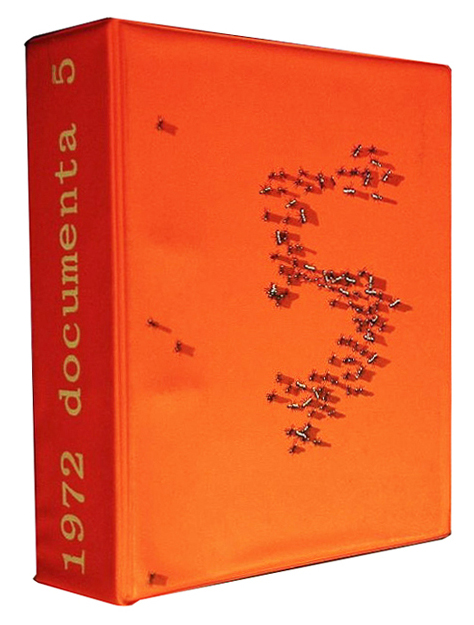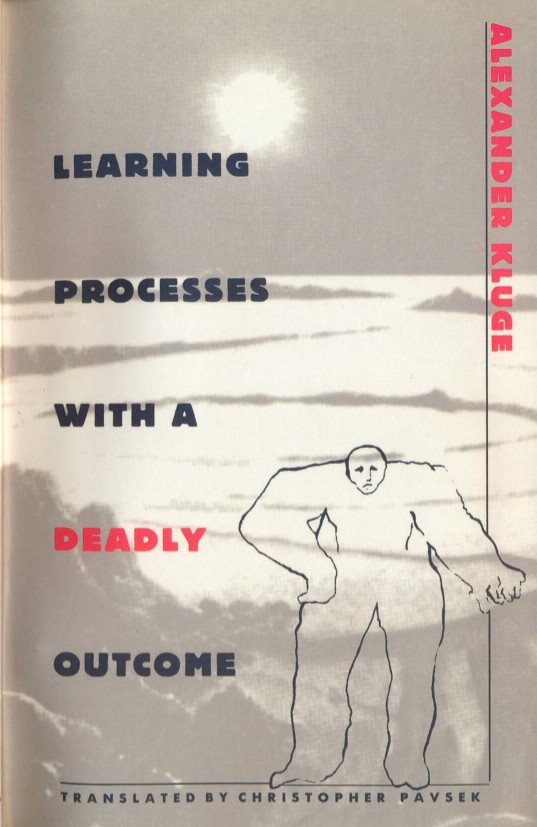monochrom, 11-23 (2000-2004) [German]
Filed under magazine | Tags: · art, conspiracy, copyleft, copyright, media, media art, media culture, net culture, philosophy, politics, science fiction, software, subversion, surveillance, tactical media, technology


The mouthpiece of an international art-technology-philosophy collective founded in 1993, with its headquarters at Museumsquartier in Vienna.
“Das Fanzine monochrom ist ein im Telefonbuch-Format erscheinendes Zeitschriftenobjekt, das von der gleichnamigen Künstler_innengruppe aus Wien, Graz und Bamberg/Deutschland herausgegeben wird. monochrom ist ein Potpourri der digitalen und analogen Subversion, ein unnostalgisches Amalgam aus 125 Jahren abendländischer Gegenkultur, die Godzilla-Variante der gutbügerlichen Coffeetablebuch-Idee.”
Editor-in-chief: Johannes Grenzfurthner
Publisher monochrom, Vienna
ISSN 1024-6738
Publisher, (2)
monochrom on Wikipedia
PDF (No. 11-14: Ontologisches Sanierungsportfolio, 2000, 260 pp)
PDF (No. 15-23: Zweite Ordnung muss sein, 2004, 436 pp)
Harald Szeemann, et al.: Documenta 5, catalogue (1972) [DE]
Filed under catalogue | Tags: · advertising, art, conceptual art, film, institutional critique, light art, museum, outsider art, performance art, politics, propaganda, realism, science fiction, systems art, utopia

“Even decades later, Documenta 5, the exhibition that was criticized in 1972 as being “bizarre.. vulgar.. sadistic” by Hilton Kramer (NYT) and “monstrous.. overtly deranged” by Barbara Rose (NYM), resonates today as one of the most important exhibitions in history. Both hailed and derided by artists and critics, the exhibition was the largest, most expensive and most diverse of any exhibition anywhere, and foreshadowed all large-scale, collaboratively curated, comprehensive mega-shows to come.
Chiefly curated by the Swiss curator, Harald Szeemann, it was a pioneering, radically different presentation that was conceived as a 100-day event, with performances and happenings, outsider art, even non-art, as well as repeated Joseph Beuys lectures, and an installation of Claes Oldenburg’s Mouse Museum, among many other atypical inclusions. The show widely promoted awareness of a contract known as The Artist’s Reserved Rights Transfer and Sale Agreement, which protects artists’ ongoing intellectual and financial rights with regard to their production.” (Source)
“Featuring the works of over 170 artists and an equally expansive variety of materials and subjects drawn from popular cultural materials such as science fiction publications, kitsch objects, exploitation films, as well as advertising imagery, in addition to the more anticipated painting and sculpture – Documenta 5 valiantly attempted to bridge the gap between art, culture, science and the broader society.
A lasting highlight of the exhibition was the graphic logo for the show designed by Edward Ruscha. Commissioned by Szeeman, Ruscha’s graphic image for the show featured ants arranged in the word ‘Docu / menta’ and the number ‘5.’ The emblem was used on the exhibition’s poster and catalogue cover.” (Source)
Contents of Part B:
1 Hans Heinz Holz: Kritische Theorie des ästhetischen Zeichens (catalogue foreword, 86 pp),
2 Bazon Brock & Karl Heinz Krings: Audiovisuelles Vorwort (audiovisual foreword, 19 pp),
3 Eberhard Roters: Trivialrealismus & Trivialemblematik (16 pp),
4 Ingolf Bauer: Bilderwelt und Froemmigkeit (10 pp),
5 Gesellschaftliche Ikonographie an zwei Beispielen (8 pp),
6 Charles Wilp, Hans Heinz Holz: Werbung (4 pp),
7 Reiner Diederich, Richard Grübling, Klaus Staeck: Politische Propaganda (14 pp),
8 Pierre Versins: Science Fiction/Heute von gestern gesehen (10 pp),
9 François Burkhardt: Utopie/Morgen von gestern gesehen (16 pp),
10 Ursula Barthelmess, Hans-Henning Borgelt, Linde Burkhardt, Wolfgang Hoebig: Spiel und Wirklichkeit (14 pp),
11 Theodor Spoerri: Bildnerei der Giesteskranken (18 pp),
12 Gerhard Buettenbender, Sigurd Hermes: Film (28 pp),
13 Museen von Künstlern (17 pp),
14 Sozialistischer Realismus (1 p),
15 Jean-Christophe Ammann: Realismus (58 pp),
16 Johannes Cladders, Harald Szeemann: Individuelle Mythologien – Selbstdarstellung: a) Performance, b) Film – Prozesse (220 pp),
17 Konrad Fischer, Klaus Honnef, Gisela Kaminski: Idee + Idee / Licht (92 pp),
18 Information + The Artist’s Reserved Rights Transfer and Sale Agreement (44 pp),
19 Verzeichnis der ausgestellten Werke
20 Allgemeine Bibliographie
21 Waehrend: Ereigniskalender
22 Nachher 1: Text
23 Nachher 2: Bild
24 Nachher 3: Presse
25 Fotonachweis
documenta 5. Befragung der Realität – Bildwelten heute
Edited by Harald Szeemann, Marlis Grüterich, Katia von den Velden, Jennifer Gough-Cooper
Publisher documenta and Bertelsmann, Kassel, 1972
ISBN 3570028569, 9783570028568
64+80 & 740+ pages
via The DOR (at Archive.org)
Analyses and commentaries:
3sat TV documentary (video, 41 min, 1972, DE)
Der Spiegel (1972, DE)
Klaus Herding & Hans-Ernst Mittig on Holz’s foreword (Kritische Berichte, 1973, DE)
Documenta 5 in Art Since 1900 (2004, EN)
Dirk Schwarze (Documenta Archiv, 2014, DE)
Maria Bremer (Stedelijk Studies, 2015, EN)
documenta Archiv, (2)
Wikipedia (DE)
WorldCat
Part A (144 pp, PDF, 57 MB)
Part B (740+ pp, PDF, 287 MB, sections 19-24 missing; updated on 2023-3-28)
Alexander Kluge: Learning Processes with a Deadly Outcome (1973–)
Filed under fiction | Tags: · capitalism, montage, science fiction, utopia

“Written in a quasi-documentary style, this fascinating hybrid work combines science fiction with modernist forms of montage and reportage to describe a future in which Earth has been almost totally destroyed following the catastrophic Black War. The planet’s remaining inhabitants have been driven underground or into space where the struggle to establish a new society rages on.
Whether describing the scene in China where the devastated landscape is reconstructed according to old paintings, or in the galactic realm of the Starway where giant, turf-battling, corporate colonizing forces exploit the universe’s resources, Kluge tells his tale by inventing various forms of “evidence” that satirize the discourses of administrative bureaucracy, the law, military security, and the media. He gives us some of his most bizarre and hilarious characters in this peculiar world in which the remains of the past are mixed with the most advanced elements of the future. The cast includes highly specialized women workers who have adapted to the massive gravitational field of their heavy-metal planets, a commander with lethal foot-fungus, and ex-Nazi space pioneers who, in their lonely exile from the conflagrations on earth, spend their time carving enormous facsimiles of operatic sheet music in the forests of uninhabited planets.
With parody, and humor, Kluge shows how the survivors of Armageddon attempt to learn the art of civilization, and, despite the disaster they have suffered, how they set out to reproduce at new sites a caricature of a classic and fascistic feudal capitalism.” (from the back cover)
First published as Lernprozesse mit tödlichem Ausgang, Suhrkamp, Frankfurt am Main, 1973.
Translated, with an Introduction and Afterword by Christopher Pavsek
Publisher Duke University Press, 1996
ISBN 0822317443, 9780822317449
xiv+112 pages
via Charles
PDF (21 MB, no OCR)
More from Kluge.

